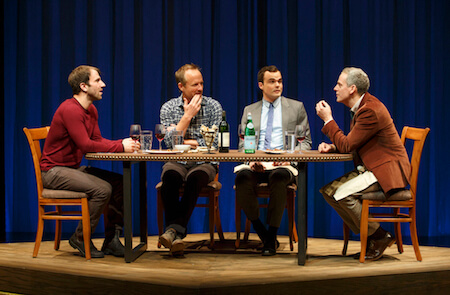Baroness Eloise von Wagner with her two lovers, Robert Philippson and Rudolf Lorenz. | ZEITGEIST FILMS
The pre-credit sequence of “The Galapagos Affair: Satan Came to Eden” promises a “strange and sinister drama” and uses dramatic headlines to sensationalize the fact that it contains “one mystery on top of another.” It’s true there are some intriguing moments, but this overlong documentary, by Daniel Geller and Dayna Goldfine, moves as slowly as the giant tortoises that inhabit the island paradise of Floreana, where much of the action unfolds. And, viewers unfamiliar with the source material (“Satan Came to Eden” by Dore Strauch, one of the documentary’s key players) will need a scorecard to keep track of the many extraneous characters.
This strange but true story opens in 1929. Friedrich Ritter (voiced by Thomas Kretschmann), decides to turn his back on civilization and live with his mistress Dore Strauch (voiced by Cate Blanchett) at the “world’s end,” in the Galapagos Islands. Ritter didn’t quite fit into conventional Berlin society; he was a “genius with a dark side.” When “intruders” come to Floreana after he and his wife have settled there, we see just how little he was able to get along with others.
The film sets up that conflict with the arrival of Heinz (voiced by Sebastian Koch) and Margret (voiced by Diane Kruger) Wittmer. The new arrivals adapt well to island life, while vegetarians Friedrich and Dore (who has multiple sclerosis) struggle and find their new home is no place to rest. The tense situation is further complicated by the arrival of Baroness Eloise von Wagner Bosquet (voiced by Connie Nielsen), who is accompanied by Robert Philippson and Rudolf Lorenz, her two lovers. She hopes to realize her dream of building a grand hotel on the island.
Documentary about a dysfunctional paradise tosses the needle into a haystack
Suffice it to say, the baroness’ arrival manages to disrupt both of the other couples. When she receives gifts from visitors, it sparks jealousy. And she generates headlines — and, who knows, they might have been true — about being surrounded by a court of 12 noblemen and having a terror regiment at her command. In one of the film’s best vignettes, a pirate film the Baroness made, entitled “The Empress of Floreana,” is shown, and features seduction, betrayal, and even some cross-dressing. Midway through the short, it is revealed that the Baroness may not be who she says she is. This is an interesting, though not wholly unexpected wrinkle in a story full of twists.
“The Galapagos Affair” raises far more questions than it gets close to answering. Was there jealousy among the women? Did the baroness have an affair with Ritter? And when the baroness and Philippson disappear, were they murdered? Lorenz’s insistence on selling his lover’s things makes for dramatic moments, and the filmmakers suggest that two of the baroness’ prized possessions — a copy of “The Picture of Dorian Gray” and a tablecloth — turning up after she is “gone” point to her being murdered.
Geller and Goldfine play up the idea that “everyone has a motive” for killing the baroness, but most of what we learn is speculative. “The Galapagos Affair” espouses theories that play out without payoff. When Ritter dies, there are two stories — one from Dore and one from Margret — that “explain” his demise. Audiences are asked to choose the one they think is appropriate. It is an unsatisfying approach to the mystery.
The film includes interviews with living descendants of Floreana families, who talk about growing up on the island as a wonderful experience but also suggest evidence the island might be haunted. We also learn about a history of inbreeding, when Carmen Angermeyer explains how it is that her father-in-law was also her brother-in-law — an amusing story, but one irrelevant to the film’s central mysteries.
We see Ritter’s childhood home and a scene from the family gravesite, and also learn how scarred he was by World War I. That may or may not explain his need to drop out of society — unfortunately the information just hangs there. The filmmakers’ showcasing of the Galapagos’ flora and fauna provides viewers with narrative downtime to absorb all the dense information presented, but it is also a reminder of much more efficiently they could have told their story.
That said, the use of photographs, film clips, and voiceovers of letters and other published writing left from those years is very well done. The unsolved mystery of the baroness’ disappearance could make for an interesting film. It’s unfortunate that in a film packed with detail, “The Galapagos Affair’ buried that lede.
THE GALAPAGOS AFFAIR: SATAN CAME TO EDEN | Directed by Daniel Geller and Dayna Goldfine | Zeitgeist Films | Opens April 4 | Lincoln Plaza Cinemas, 1886 Broadway at 63rd St. | lincolnplazacinema.com



































